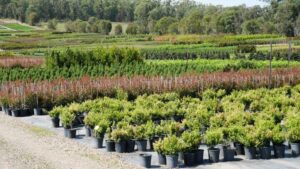
Nursery production – a science
By Patrick Regnault
When selecting plants for our landscape projects we look for well-formed, healthy, and disease-free plants with a well-developed root system. Nurseries spend time and effort finding a mix that is right for the stock they produce, and their geographical location dictates the type of media to which they have access.
Soil is a rare commodity that cannot be taken for granted and a lesser quality potting mix can ruin a season of work. For this article we will hear from different nursery people and discuss their requirements, their thoughts, and their observations.
What are you looking for in a potting mix? Stephanie from Miss Tree replied that, for her, it was a good open structure that lasts and does not breakdown too quickly, and enough nutrient content to sustain health and vigour. By using smaller loads quickly, the fertiliser in the mix does not leach out whilst sitting on the pile. Other nurseries who go through larger quantities of mixes prefer to have no fertiliser, or only slow release added into the mix, as they then add fertiliser as required following plant needs.
For Damien from Parkers Place, consistency, homogeneity and stability are especially important factors. Stability of the product is essential to avoid slump in pots. Jason from Remarkable trees in Victoria uses air-pruning pot systems, and the mix he uses has been formulated to suit his needs. For him it is important to choose a supplier who can give professional advice and a product that is regularly tested for quality.
The type of plants grown will require adjustment to the base mix to take into consideration pH levels, fertiliser sensitivity, and the needs of plants that require a more open structure, as in the case of Cycads which require more coarse sand.
For Nicholas Rivett, a forensic agriculturist and horticulturist from Victoria, soil or media is simply a transient material for nutrients to leave the profile and enter the plant. Soil also provides structural integrity.
When choosing the right growing media, factors must be considered such as the type of plants that will be grown, what type of pot, and how long is it likely to be in the pot, the watering system and fertiliser regime, and the climate you are in.
The media needs to be of suitable particle size so that there is a substantial surface area per cubic centimetre. It needs to be able to carry nutrients, provide a level of structural integrity to hold the plant up, have good gas exchange, carbon dioxide and oxygen, and not be overly wet and cold, or too low in water carrying capacity in high-temperature areas.
Natural soils in potting mixes can aid in transporting pathogens into other areas of the country and may become prohibited goods in states such as Tasmania, Western Australia, Northern Territory and to some extent Queensland.
In the last five years, the price of potting mixes has increased 125%. There are many factors that led to the price rise. At one point pine bark was scarce, in part due to the species developed for pine plantations which had a higher pulp content and thinner bark layer, and on the other hand the competition from biofuel companies that bought the bark to create energy. Fires, droughts and floods impact the availability of materials in the medium and long term. Transportation disruption and a rise in petrol prices affects the prices of goods down the line. Nurseries, like all businesses, can’t keep absorbing costs; they must pass the increases on, and efficiency has its limits.
Growing media has become more sustainable over the last decades with coco fibres and coco chips replacing peat, thus removing one of the threats to threatened peat bogs.
Until the 1960s and early 1970s composted leaf litter was used in potting mixes. It may not have been known why this helped the plants, but we now know that the mycorrhizae in leaf mulch increased the plant’s water and nutrient absorption capabilities.
Growing media is an extraordinarily complex affair. Growing quality plants requires expertise in many domains, including biology and chemistry. Plant husbandry is a science and needs to be taught as such if we want this industry to produce for generations to come.
Patrick Regnault FAIH RH0062
Interactive Landscapes
E: patrickregnault@hotmail.com
